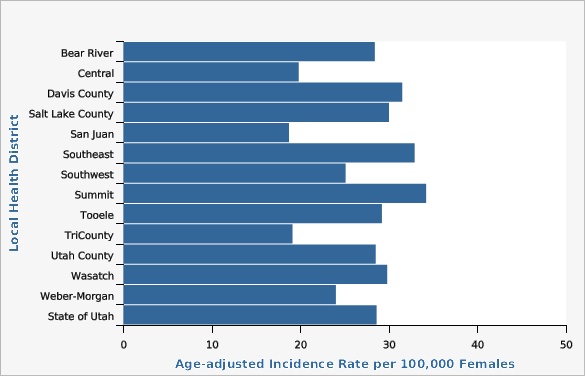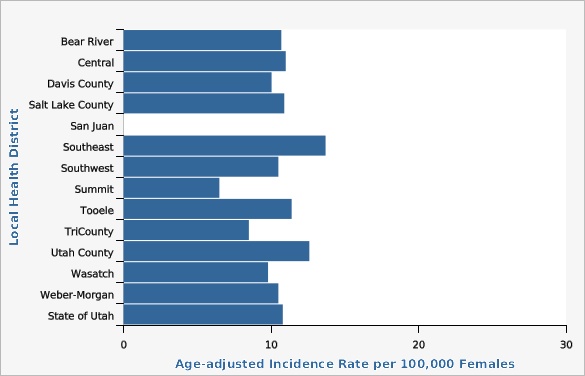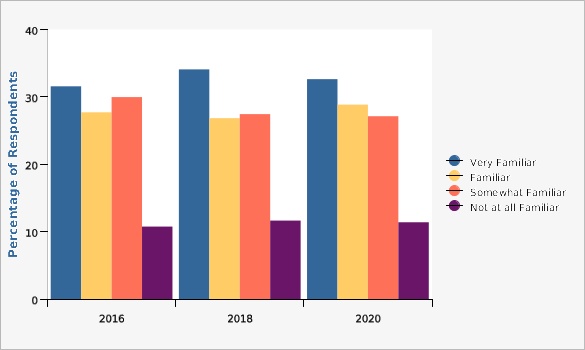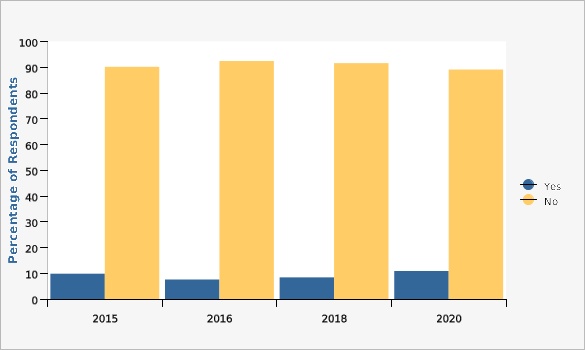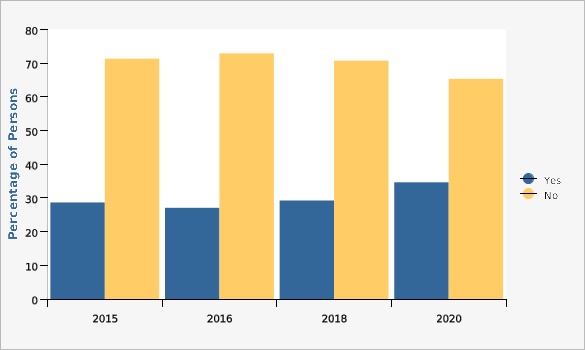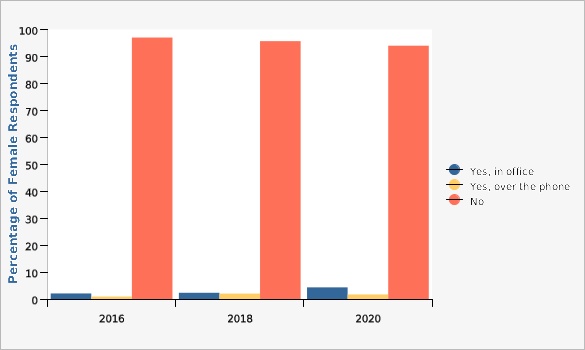Complete Health Indicator Report of Hereditary Breast and Ovarian Cancer
Definition
The rate of breast or ovarian cancer incidence in Utah or U.S. per 100,000 females.Numerator
The number of breast or ovarian cancer cases among Utah or U.S. for a specified time period.Denominator
The female population of Utah or U.S. for a specified time period.Why Is This Important?
Hereditary cancer syndromes are genetic predispositions for certain types of cancer that can be passed down through generations. Hereditary Breast and Ovarian Cancer Syndrome (HBOC) is caused by mutations in the BRCA1 and BRCA2 genes and is associated with an increased risk of breast and ovarian cancer. BRCA mutations increase a woman's risk of breast cancer by 45-65% and ovarian cancer by 10-39%.^1^ Men with BRCA mutations are also at an increased risk for breast cancer, especially if they have a BRCA2 mutation.^1^ While hereditary cancers only account for about 10% of all cancers, people with family history of hereditary cancers are at higher risk for getting cancer more than once in their lifetimes, more likely to get cancer at a younger age, and more likely to be diagnosed when the cancer is at a later, more advanced stage.^2^ [[br]] [[br]] ---- 1. Centers for Disease Control and Prevention. (2014, Mar 06). More detailed information on key tier 1 applications - Hereditary breast and ovarian cancer (HBOC). [https://www.cdc.gov/genomics/implementation/toolkit/hboc_1.htm] [[br]] 2. Centers for Disease Control and Prevention. (2020, Aug 03). Cancer genomics program. [[https://www.cdc.gov/cancer/dcpc/about/genomics/index.htm]Healthy People Objective G-1:
Increase the proportion of women with a family history of breast and/or ovarian cancer who receive genetic counselingU.S. Target: 38.1 percent
Other Objectives
'''Utah Cancer Action Network Targets for Change:'''[[br]] Reduce the rate of breast cancer diagnosed at an advanced (regional or distant) stage among women ages 40 to 74. [[br]] '''Utah 2020 Target:''' 80 per 100,000 womenHow Are We Doing?
Female breast cancer incidence under age 50 has not significantly changed over the years, however ovarian cancer incidence has increased in recent years.How Do We Compare With the U.S.?
Throughout the years, the Utah female breast cancer under age 50 incidence rate has been consistently lower than the U.S. rate. Ovarian cancer rate has continually fluctuated over the years with some years experiencing greater rates than the U.S. rate and some years lower.What Is Being Done?
The Utah Cancer Genomics Program (UCGP) collaborates with community organizations and health systems to provide public/provider education, improve referral processes, and improve access to genetic counseling and testing. These organizations reach many populations throughout the state and provide a variety of services. The UCGP holds and annual Request for Proposals (RFP) competitive application process and awards funding to innovative projects that have the potential to drive Policy, Systems, and Environmental change in public awareness of Family Health History and referral to and uptake of appropriate genetic services. This mini-grant enables strong partnerships between the UCGP and health systems, clinics, and community-based organizations and expands the program's reach into the community. In addition, the UCGP participates in the Utah Cancer Action Network (UCAN), a statewide partnership whose goal is to reduce the burden of cancer. The mission of UCAN is to lower cancer incidence and mortality in Utah through collaborative efforts directed toward cancer prevention and control. As a result of this planning process, objectives and strategies have been developed by community partners regarding the early detection of cervical, breast, and colorectal cancers and separate cancer genomics collaboration opportunities are also available.Available Services
The Utah Cancer Control Program (UCCP) provides free or low cost clinical breast exams and mammograms to women who meet age and income guidelines. Eligible women with abnormal screening exams are offered diagnostic evaluation by participating providers. As of July 1, 2001, the UCCP has been able to refer Utah women in need of treatment for breast and cervical cancers for full Medicaid benefits. Participants must meet all requirements as outlined in the National Breast and Cervical Cancer Treatment Act. Coverage of preventive screening tests including mammograms and clinical breast exams is required by the United States Preventive Services Task Force (USPSTF) created by the Affordable Care Act (ACA), as is genetic testing for BRCA1/2 variations associated with hereditary breast and ovarian cancer.Health Program Information
In 2014 the Utah Department of Health received funding from the CDC to implement a program focused on addressing the cancer burden associated with hereditary cancer syndromes. The UCGP continues to receive funding from the CDC for surveillance, education, improving access to and referrals to genetic services, and bolstering partnerships with healthcare organizations, non-profit organizations, and other community organizations.Related Indicators
Relevant Population Characteristics
Persons without health insurance are less likely to undergo cancer screenings, which can delay access to necessary services including cancer treatment and genetic counseling and testing. Additionally, women are more likely to receive screening as their level of education increases. Screening is vital in diagnosing potential hereditary breast and ovarian cancer, so it is important to examine the potential barriers to screening for Utah women.Related Relevant Population Characteristics Indicators:
Health Care System Factors
According to data collected by the Utah Behavioral Risk Factor Surveillance Systems (BRFSS), screening rates for all Utahns remain lower than the national average and lower than the target rates set by the Utah State Cancer Plan (76%). Additionally, use of mammography is lower among women without health insurance compared to women with health insurance. Coverage of preventive breast cancer screening tests such as mammography and clinical breast exams is required by the Affordable Care Act (ACA). Similarly, genetic testing for BRCA1/2 is required without patient cost-sharing under the ACA for women with a family history of HBOC. Screening is vital in diagnosing potential hereditary breast and ovarian cancer, so it is important to examine the potential barriers to screening for Utah women.Related Health Care System Factors Indicators:
Related Health Status Outcomes Indicators:
Graphical Data Views
Breast Cancer Under Age 50 Incidence by Year, Utah and U.S., 1999-2018
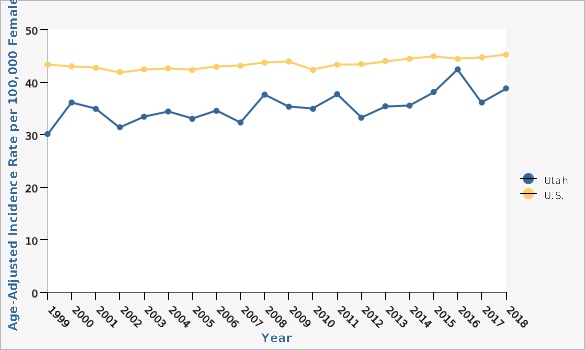
| Utah vs. U.S. | Year | Age-Adjusted Incidence Rate per 100,000 Females | ||||
|---|---|---|---|---|---|---|
Record Count: 40 | ||||||
| Utah | 1999 | 30.1 | ||||
| Utah | 2000 | 36.1 | ||||
| Utah | 2001 | 34.9 | ||||
| Utah | 2002 | 31.4 | ||||
| Utah | 2003 | 33.4 | ||||
| Utah | 2004 | 34.4 | ||||
| Utah | 2005 | 33.0 | ||||
| Utah | 2006 | 34.5 | ||||
| Utah | 2007 | 32.3 | ||||
| Utah | 2008 | 37.6 | ||||
| Utah | 2009 | 35.3 | ||||
| Utah | 2010 | 34.9 | ||||
| Utah | 2011 | 37.7 | ||||
| Utah | 2012 | 33.2 | ||||
| Utah | 2013 | 35.4 | ||||
| Utah | 2014 | 35.5 | ||||
| Utah | 2015 | 38.1 | ||||
| Utah | 2016 | 42.4 | ||||
| Utah | 2017 | 36.1 | ||||
| Utah | 2018 | 38.8 | ||||
| U.S. | 1999 | 43.3 | ||||
| U.S. | 2000 | 43.0 | ||||
| U.S. | 2001 | 42.7 | ||||
| U.S. | 2002 | 41.9 | ||||
| U.S. | 2003 | 42.4 | ||||
| U.S. | 2004 | 42.6 | ||||
| U.S. | 2005 | 42.3 | ||||
| U.S. | 2006 | 42.9 | ||||
| U.S. | 2007 | 43.1 | ||||
| U.S. | 2008 | 43.7 | ||||
| U.S. | 2009 | 43.9 | ||||
| U.S. | 2010 | 42.3 | ||||
| U.S. | 2011 | 43.3 | ||||
| U.S. | 2012 | 43.4 | ||||
| U.S. | 2013 | 44.0 | ||||
| U.S. | 2014 | 44.4 | ||||
| U.S. | 2015 | 44.9 | ||||
| U.S. | 2016 | 44.4 | ||||
| U.S. | 2017 | 44.7 | ||||
| U.S. | 2018 | 45.2 | ||||
Data Notes
Age-adjusted to U.S. 2000 standard population.Data Sources
- Population Estimates: National Center for Health Statistics (NCHS) through a collaborative agreement with the U.S. Census Bureau, IBIS Version 2021
- Cancer data provided by the Utah Cancer Registry, supported by the National Cancer Institute (HHSN261201800016I), the U.S. Center for Disease Control and Prevention (NU58DP0063200), the University of Utah, and Huntsman Cancer Foundation
- U.S. Cancer Statistics: WONDER Online Database. United States Department of Health and Human Services, Centers for Disease Control and Prevention and National Cancer Institute. Accessed at [http://wonder.cdc.gov/cancer.html]
Ovarian Cancer Incidence by Year, Utah and U.S., 1999-2018
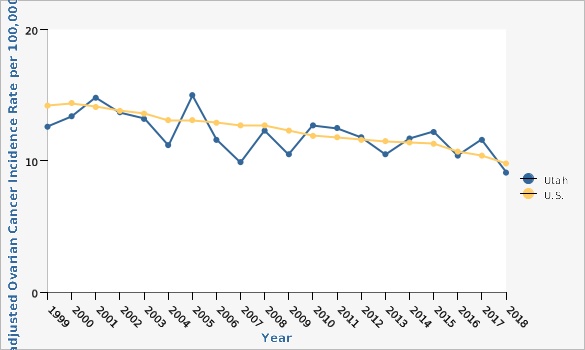
| Utah vs. U.S. | Year | Age-adjusted Ovarian Cancer Incidence Rate per 100,000 Females | ||||
|---|---|---|---|---|---|---|
Record Count: 40 | ||||||
| Utah | 1999 | 12.6 | ||||
| Utah | 2000 | 13.4 | ||||
| Utah | 2001 | 14.8 | ||||
| Utah | 2002 | 13.7 | ||||
| Utah | 2003 | 13.2 | ||||
| Utah | 2004 | 11.2 | ||||
| Utah | 2005 | 15.0 | ||||
| Utah | 2006 | 11.6 | ||||
| Utah | 2007 | 9.9 | ||||
| Utah | 2008 | 12.3 | ||||
| Utah | 2009 | 10.5 | ||||
| Utah | 2010 | 12.7 | ||||
| Utah | 2011 | 12.5 | ||||
| Utah | 2012 | 11.8 | ||||
| Utah | 2013 | 10.5 | ||||
| Utah | 2014 | 11.7 | ||||
| Utah | 2015 | 12.2 | ||||
| Utah | 2016 | 10.4 | ||||
| Utah | 2017 | 11.6 | ||||
| Utah | 2018 | 9.1 | ||||
| U.S. | 1999 | 14.2 | ||||
| U.S. | 2000 | 14.4 | ||||
| U.S. | 2001 | 14.1 | ||||
| U.S. | 2002 | 13.8 | ||||
| U.S. | 2003 | 13.6 | ||||
| U.S. | 2004 | 13.1 | ||||
| U.S. | 2005 | 13.1 | ||||
| U.S. | 2006 | 12.9 | ||||
| U.S. | 2007 | 12.7 | ||||
| U.S. | 2008 | 12.7 | ||||
| U.S. | 2009 | 12.3 | ||||
| U.S. | 2010 | 11.9 | ||||
| U.S. | 2011 | 11.8 | ||||
| U.S. | 2012 | 11.6 | ||||
| U.S. | 2013 | 11.5 | ||||
| U.S. | 2014 | 11.4 | ||||
| U.S. | 2015 | 11.3 | ||||
| U.S. | 2016 | 10.7 | ||||
| U.S. | 2017 | 10.4 | ||||
| U.S. | 2018 | 9.8 | ||||
Data Notes
Age-adjusted to U.S. 2000 standard population.| Local Health District | Age-adjusted Incidence Rate per 100,000 Females | Lower Limit | Upper Limit | Note | ||
|---|---|---|---|---|---|---|
Record Count: 14 | ||||||
| Bear River | 28.4 | 22.7 | 35.2 | |||
| Central | 19.8 | 13.0 | 28.9 | |||
| Davis County | 31.5 | 27.5 | 36.0 | |||
| Salt Lake County | 30.0 | 27.8 | 32.3 | |||
| San Juan | 18.7 | 6.1 | 43.7 | * | ||
| Southeast | 32.9 | 21.0 | 49.0 | |||
| Southwest | 25.1 | 20.4 | 30.5 | |||
| Summit | 34.2 | 23.6 | 48.0 | |||
| Tooele | 29.2 | 21.0 | 39.6 | |||
| TriCounty | 19.1 | 11.7 | 29.3 | |||
| Utah County | 28.5 | 25.4 | 32.0 | |||
| Wasatch | 29.8 | 17.9 | 46.6 | |||
| Weber-Morgan | 24.0 | 19.9 | 28.6 | |||
| State of Utah | 28.6 | 27.3 | 30.0 | |||
Data Notes
Age-adjusted to U.S. 2000 population. [[br]] *Use caution in interpreting, the estimate has a relative standard error greater than 30% and does not meet UDOH standards for reliability. For more information, please go to [http://ibis.health.utah.gov/pdf/resource/DataSuppression.pdf].[[br]] [[br]]Note: Prior to 2015 San Juan County was part of the Southeast Local Health District. In 2015 the San Juan Local Health District was formed. Data reported are for all years using the current boundaries.Ovarian Cancer Incidence by Ethnicity, Utah, 2014-2018

Data Notes
Age-adjusted to U.S. 2000 population.Ovarian Cancer Incidence by Race, Utah, 2013-2018

Data Notes
Age-adjusted to U.S. 2000 population. [[br]] [[br]] *Use caution in interpreting, the estimate has a relative standard error greater than 30% and does not meet UDOH standards for reliability. [[br]]**The estimate has been suppressed because the observed number of events is very small and not appropriate for publication. For more information, please go to [http://ibis.health.utah.gov/pdf/resource/DataSuppression.pdf] [[br]]| Local Health District | Age-adjusted Incidence Rate per 100,000 Females | Lower Limit | Upper Limit | Note | ||
|---|---|---|---|---|---|---|
Record Count: 14 | ||||||
| Bear River | 10.7 | 7.7 | 14.6 | |||
| Central | 11.0 | 7.0 | 16.4 | |||
| Davis County | 10.0 | 7.9 | 12.6 | |||
| Salt Lake County | 10.9 | 9.6 | 12.2 | |||
| San Juan | ** | 3.0 | 27.9 | **,^ | ||
| Southeast | 13.7 | 7.5 | 23.1 | ^ | ||
| Southwest | 10.5 | 8.0 | 13.5 | |||
| Summit | 6.5 | 2.6 | 13.6 | * | ||
| Tooele | 11.4 | 6.3 | 18.9 | * | ||
| TriCounty | 8.5 | 4.2 | 15.4 | * | ||
| Utah County | 12.6 | 10.4 | 15.0 | |||
| Wasatch | 9.8 | 3.8 | 20.7 | * | ||
| Weber-Morgan | 10.5 | 8.1 | 13.4 | |||
| State of Utah | 10.8 | 10.1 | 11.6 | |||
Data Notes
Age-adjusted to U.S. 2000 population. [[br]] [[br]] *Use caution in interpreting, the estimate has a relative standard error greater than 30% and does not meet UDOH standards for reliability. [[br]] ^ ^**The estimate has been suppressed because the observed number of events is very small and not appropriate for publication. For more information, please go to [http://ibis.health.utah.gov/pdf/resource/DataSuppression.pdf] [[br]] ^Prior to 2015 San Juan County was part of the Southeast Local Health District. In 2015 the San Juan County Local Health District was formed. Data reported are for all years using the current boundaries.Male Breast Cancer Incidence by Year, Utah and U.S., 1999-2018
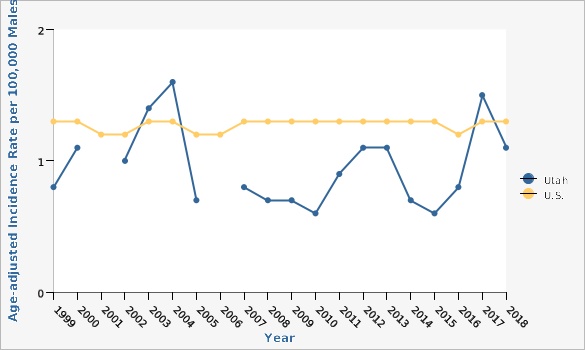
| Utah vs. U.S. | Year | Age-adjusted Incidence Rate per 100,000 Males | Note | |||
|---|---|---|---|---|---|---|
Record Count: 40 | ||||||
| Utah | 1999 | 0.8 | * | |||
| Utah | 2000 | 1.1 | * | |||
| Utah | 2001 | ** | ** | |||
| Utah | 2002 | 1.0 | * | |||
| Utah | 2003 | 1.4 | ||||
| Utah | 2004 | 1.6 | ||||
| Utah | 2005 | 0.7 | * | |||
| Utah | 2006 | ** | ** | |||
| Utah | 2007 | 0.8 | * | |||
| Utah | 2008 | 0.7 | * | |||
| Utah | 2009 | 0.7 | * | |||
| Utah | 2010 | 0.6 | * | |||
| Utah | 2011 | 0.9 | * | |||
| Utah | 2012 | 1.1 | ||||
| Utah | 2013 | 1.1 | ||||
| Utah | 2014 | 0.7 | * | |||
| Utah | 2015 | 0.6 | * | |||
| Utah | 2016 | 0.8 | * | |||
| Utah | 2017 | 1.5 | ||||
| Utah | 2018 | 1.1 | ||||
| U.S. | 1999 | 1.3 | ||||
| U.S. | 2000 | 1.3 | ||||
| U.S. | 2001 | 1.2 | ||||
| U.S. | 2002 | 1.2 | ||||
| U.S. | 2003 | 1.3 | ||||
| U.S. | 2004 | 1.3 | ||||
| U.S. | 2005 | 1.2 | ||||
| U.S. | 2006 | 1.2 | ||||
| U.S. | 2007 | 1.3 | ||||
| U.S. | 2008 | 1.3 | ||||
| U.S. | 2009 | 1.3 | ||||
| U.S. | 2010 | 1.3 | ||||
| U.S. | 2011 | 1.3 | ||||
| U.S. | 2012 | 1.3 | ||||
| U.S. | 2013 | 1.3 | ||||
| U.S. | 2014 | 1.3 | ||||
| U.S. | 2015 | 1.3 | ||||
| U.S. | 2016 | 1.2 | ||||
| U.S. | 2017 | 1.3 | ||||
| U.S. | 2018 | 1.3 | ||||
Data Notes
Age-adjusted to U.S. 2000 population. [[br]] ^*Count less than 11 [[br]] ^**The statistic is not displayed due to fewer than 11 cases and not appropriate for publication. For more information, please go to [http://ibis.health.utah.gov/pdf/resource/DataSuppression.pdf] [[br]]Triple Negative Breast Cancer Incidence Rate by Year, Utah 2010-2018
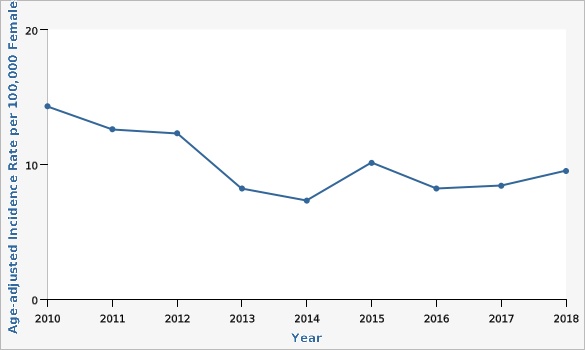
| Year | Age-adjusted Incidence Rate per 100,000 Females | |||||
|---|---|---|---|---|---|---|
Record Count: 9 | ||||||
| 2010 | 14.3 | |||||
| 2011 | 12.6 | |||||
| 2012 | 12.3 | |||||
| 2013 | 8.2 | |||||
| 2014 | 7.3 | |||||
| 2015 | 10.1 | |||||
| 2016 | 8.2 | |||||
| 2017 | 8.4 | |||||
| 2018 | 9.5 | |||||
Data Source
Cancer data provided by the Utah Cancer Registry, supported by the National Cancer Institute (HHSN261201800016I), the U.S. Center for Disease Control and Prevention (NU58DP0063200), the University of Utah, and Huntsman Cancer FoundationData Notes
How familiar are you with your family history of cancer among blood relatives including your parents, grandparents, siblings, aunts, uncles, and children?Data Source
Utah Department of Health and Human Services Behavioral Risk Factor Surveillance System (BRFSS)Data Notes
Has a doctor, nurse, or other healthcare provider ever talked to you about genetic testing if you or your family are at increased risk for developing breast, ovarian, colorectal, or uterine cancer?Data Source
Utah Department of Health and Human Services Behavioral Risk Factor Surveillance System (BRFSS)Data Notes
Have you ever had a genetic test to determine if you or your family is at increased risk of developing cancer? [[br]] [[br]]*Question only asked to those who answered "yes", "don't know", or "refused" to previous question, 'Has a doctor, nurse, or other healthcare provider ever talked to you about genetic testing if you or your family are at increased risk for developing breast, ovarian, colorectal, or uterine cancer?'Data Source
Utah Department of Health and Human Services Behavioral Risk Factor Surveillance System (BRFSS)Data Notes
Have you ever met with a genetic counselor to discuss your risk of breast and ovarian cancer?Data Source
Utah Department of Health and Human Services Behavioral Risk Factor Surveillance System (BRFSS)References and Community Resources
Utah Cancer Control Program @ [http://www.cancerutah.org] [[br]] Utah Cancer Action Network @ [http://www.ucan.cc] [[br]] Susan G. Komen Foundation @ [http://www.komen.org] [[br]] American Cancer Society @ [http://www.cancer.org] [[br]] National Cancer Institute @ [http://www.cancer.gov] [[br]] Huntsman Cancer Institute @ [http://www.huntsmancancer.org] [[br]] Intermountain Healthcare @ [http://www.intermountainhealthcare.org/services/genomics/] [[br]] Centers for Disease Control and Prevention @ [http://www.cdc.gov] [[br]] American Society of Clinical Oncology @ [http://www.asco.org] [[br]] Imaginis--The Breast Health Specialists Breast Health Information @ [http://www.imaginis.com] [[br]] National Breast Cancer Awareness Month @ [http://www.nationalbreastcancer.org/breast-cancer-awareness-month] [[br]] National Breast Cancer Coalition @ [http://www.natlbcc.org]More Resources and Links
Evidence-based community health improvement ideas and interventions may be found at the following sites:- Centers for Disease Control and Prevention (CDC) WONDER Database, a system for disseminating public health data and information.
- United States Census Bureau data dashboard.
- Utah healthy Places Index, evidence-based and peer-reviewed tool, supports efforts to prioritize equitable community investments, develop critical programs and policies across the state, and much more.
- County Health Rankings
- Kaiser Family Foundation's StateHealthFacts.org
- Medical literature can be queried at PubMed library.
Page Content Updated On 01/25/2022,
Published on 11/14/2022

